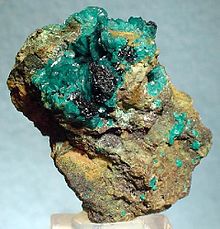Liroconite is a complex mineral: Hydrated copper aluminium arsenate hydroxide, with the formula Cu2Al[(OH)4|AsO4]·4(H2O). It is a vitreous monoclinic mineral, colored bright blue to green, often associated with malachite, azurite, olivenite, and clinoclase. It is quite soft, with a Mohs hardness of 2–2.5, and has a specific gravity of 2.9–3.0.
| Liroconite | |
|---|---|
 | |
| General | |
| Category | Arsenate minerals |
| Formula (repeating unit) | Cu2Al[(OH)4|AsO4]·4(H2O) |
| IMA symbol | Lro[1] |
| Strunz classification | 8.DF.20 |
| Crystal system | Monoclinic |
| Crystal class | Prismatic (2/m) (same H-M symbol) |
| Space group | I2/a |
| Unit cell | a = 12.66, b = 7.57 c = 9.89 [Å]; β = 91.25°; Z = 4 |
| Identification | |
| Color | Bright blue to green |
| Crystal habit | Typically as striated flattened octahedral or lenticular crystals, also massive to granular |
| Cleavage | Indistinct on {110} and {011} |
| Fracture | Irregular/uneven, conchoidal |
| Mohs scale hardness | 2–2+1⁄2 |
| Luster | Vitreous to resinous |
| Streak | Light blue |
| Diaphaneity | Transparent, translucent |
| Specific gravity | 2.9–3 |
| Optical properties | Biaxial (−) |
| Refractive index | nα = 1.612 nβ = 1.652 nγ = 1.675 |
| Birefringence | δ = 0.063 |
| 2V angle | Measured: 67° |
| References | [2][3][4] |

It was first identified in 1825 in the tin and copper mines of Devon and Cornwall, England. Although it remains quite rare it has subsequently been identified in a variety of locations including France, Germany, Australia, New Jersey and California.[2]
The type locality for liroconite is Wheal Gorland in St Day, Cornwall in the United Kingdom.[2] The largest crystal specimen on public display is in the Royal Cornwall Museum in Truro.[5]
It occurs as a secondary mineral in copper deposits in association with olivenite, chalcophyllite, clinoclase, cornwallite, strashimirite, malachite, cuprite and limonite.[4]
Structure
editLiroconite crystallizes in the monoclinic crystal system.[4]: 1 [6] The crystal structure consists of a framework of AsO4 tetrahedra, Jahn-Teller-distorted [CuO2(OH)2(H2O)2] octahedra and [AlO2(OH)4] octahedra.[7]
See also
edit- Kernowite – an isostructural mineral with iron in place of aluminium
References
edit- ^ Warr, L.N. (2021). "IMA–CNMNC approved mineral symbols". Mineralogical Magazine. 85 (3): 291–320. Bibcode:2021MinM...85..291W. doi:10.1180/mgm.2021.43. S2CID 235729616.
- ^ a b c Mindat.org: Liroconite mineral information and data
- ^ Webmineral data
- ^ a b c Handbook of Mineralogy
- ^ Aubrey-Jones, David (2008). "Liroconite".
- ^ Kolesova, R.V.; Fesenko, E.G. (Dec 1968). "Determination of the crystal structure of Liroconite Cu2Al[AsO4](OH)4 4 H2O" (PDF). Soviet Physics – Crystallography. 13 (3). Rostov University: 396–402.
- ^ Burns, Peter C.; Eby, Ray K.; Hawthorne, Frank C. (1991). "Refinement of the structure of liroconite, a heteropolyhedral framework oxysalt mineral". Acta Crystallogr. C. 47 (5): 916–919. doi:10.1107/S0108270190010939.